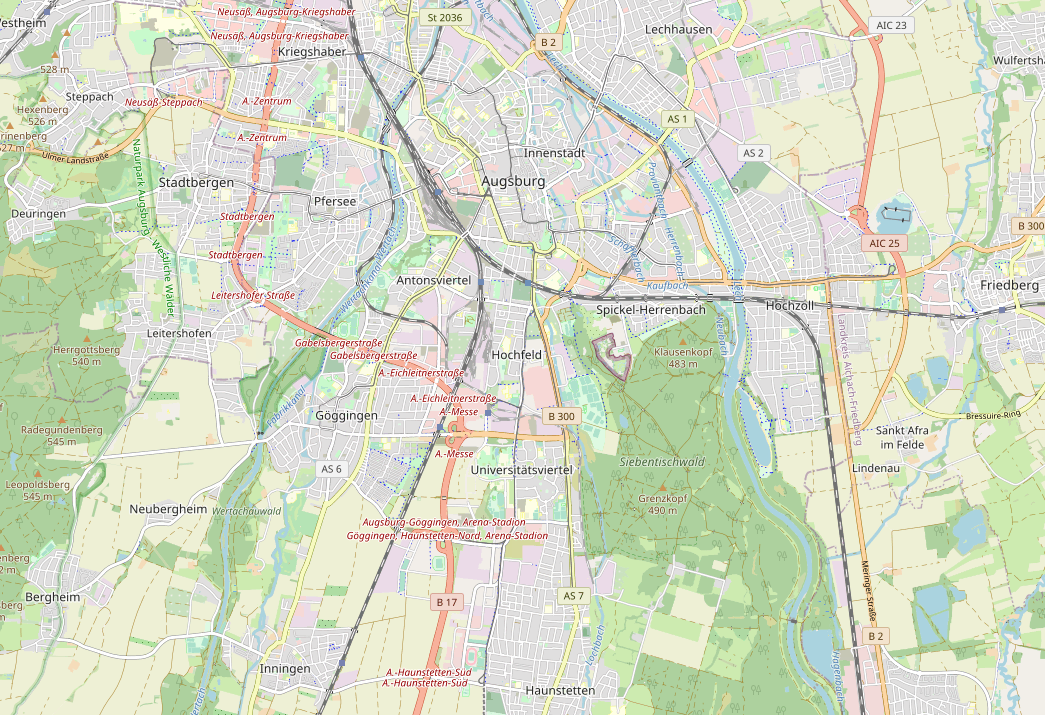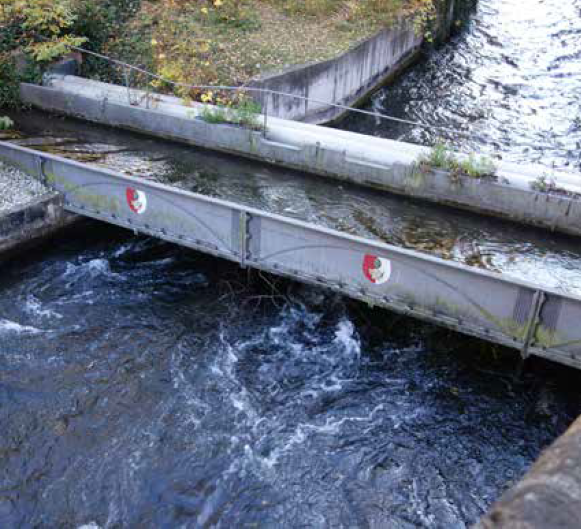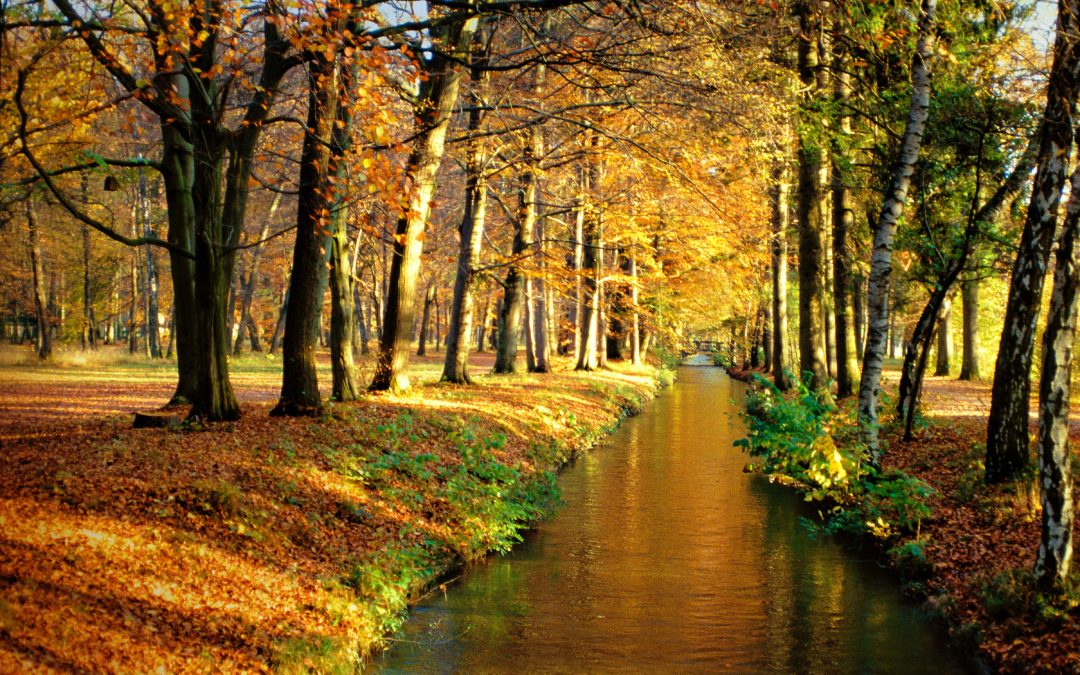By Davide Martino
Environment & History, essay no. 8
In the eighth contribution to our ‘Environment & History’ series, post-graduate researcher Davide Martino reflects on his research into hydraulic philosophy in early modern European cities, with a focus on the water supply of early Augsburg.
Martino points to how, historically, vested interests and an awareness of the services offered by an ecosystem could result in unintentional eco-schemes in a process not dissimilar to those which the EU is seeking to create today. As with Kristian Mennen’s earlier post in this series, Davide Martino’s findings suggest paying closer attention to how historical and present-day communities’ understand and utilize the benefits of local ecosystems.
Join us again on Wednesday 24 March for the next essay in the ‘Environment & History’ series, ‘Deltas after rice: agrarian pasts, environmental futures’.

Fig. 1 – Advert for a local utilities company in Augsburg, Germany. Photo by Davide Martino.
At bus stops and on trams in Augsburg, Germany, an advert for the local utilities company proclaims: ‘For one of the best drinking waters in Europe we protect a surface of over 7,000 football fields in the Siebentisch forest’ (fig. 1). This information is accompanied by a simple final statement: ‘Makes sense’. Does it? What does a forest have to do with water quality?
First, the Siebentisch forest is where the drinking water of Augsburg comes from. To be more precise, the woodland south of the city (fig. 2) is where the water comes to the surface, after having seeped into the mountain slopes of the Alps and flowed through various layers of permeable soil and rock. The springwater of the Siebentisch forest has been channelled and drunk by Augsburg citizens since the fifteenth century, if not earlier. [1] Not everyone who sees the advert may be aware of this long history, but many may have spotted the streams and pumping stations among the trees: the forest is popular with residents for walks, runs, and cycle tours.
Second, the Siebentisch forest is the last stage of the natural filtering process which makes the water fit for drinking. Water from the forest springs needs no further sanitising: it is pumped directly into Augsburg’s water supply network. [2] By analogy with other beverages, we could say that the water is brewed, or distilled, by the forest. The protection mentioned by the advert aims to ensure that the Siebentisch forest can continue to play this crucial role, without interference from activities such as farming or construction.
Today, the ability of an ecosystem—such as the Siebentisch forest—to provide a natural resource which can be used by humans—such as drinking water—is called an ‘ecosystem service’. Such services are not limited to the provision of consumable resources: ecosystems are also important in renewing soils and nutrients, as well as in regulating climate. Finally, ecosystems can offer ‘cultural services’ to human communities: the Siebentisch forest’s recreational importance for the local population is a good example. [3]

Fig. 2 – Map of the city of Augsburg, Germany. The Siebentisch forest is the large wooded area to the south-east of the city centre. Map data © OpenStreetMap contributors, CC-BY-SA.
The notion of ‘ecosystem services’ is relatively recent: it emerged in ecological research over the last thirty years. The concept of ‘ecosystem’, by contrast, dates from 1935; its author was Arthur Tansley, a British ecologist. His American colleague Frederik Clements had suggested that plant communities should be understood as (super)organisms, given the high degree of cooperation and mutual dependence within them. Tansley, who thought that the term ‘organism’ should be reserved for individual plants and animals, coined the neologism ‘ecosystem’ instead. The concept gained traction among ecologists after the Second World War, in part thanks to Eugene Odum’s 1953 textbook, Fundamentals of Ecology. By analogy with physical systems, an ‘ecosystem’ was (and is) understood to comprise both organic and inorganic components. In the case of a forest, this would mean the trees, shrubs, and grasses, the animals living under, within, and above them, but also the soil, the water, and the rocks. [4]
The residents of early modern Augsburg, however, already displayed some awareness of environmnetal interdependence four hundred years before the concept of ecosystem was invented. If we were to ask them our initial question, ‘What does a forest have to do with water quality?’, we can be confident that their response would stress the importance of water quality to the city’s inhabitants.

Figure 3 – The Siebentisch forest in the sixteenth century, seen from the east. The city of Augsburg is in the top right corner of the bird’s eye view: its separate canal networks for river water and drinking water are visible. 1588 anonymous map. Bayerisches Hauptstaatsarchiv, Plansammlung 20686.
From the fifteenth to the nineteenth century, the Free Imperial City of Augsburg maintained not one, but two parallel networks of canals (fig. 3). One was filled with the waters of the nearby river Lech, whose swift speed turned the wheels of many mills and workshops. The other was filled exclusively with springwater from the Siebentisch forest, which was pumped into wooden pipes and distributed to public and private fountains for drinking. In order to ensure that the two waters did not mix, the distance between the river Lech, which was prone to flooding, and the forest springs was measured and monitored. [5] Whenever the two networks crossed, aqueducts and wooden barriers were built (fig. 4). This rigorous separation of drinking water from river water was unusual in early modern Europe: urban dwellers across the continent, from Paris to Toledo, routinely drank river water. [6]

Fig. 4 – To this day, the Innerer Stadtgraben crosses over the Stadtbach in an aqueduct in the city centre of Augsbutg, by the Mauerberg. In the early modern period, the Innerer Stadtgraben carried drinking water, wheras the Stadtbach was filled with river water, hence the importance of keeping their flows separate. Photo by Davide Martino.
Waste disposal was perceived as another threat to the quality of Augsburg’s drinking water, and was therefore highly regulated. Human faeces could only be disposed of at night and, from 1623, only in the river Lech, not in the urban canals. From 1385, tanners were banned from discharging their waste in the canals; as for dyers, they could only pour away their hues after sunset, but never on slaughter days, for then the water was used to wash the meat and keep it cool. [7]
Did early modern Augsburgers make a connection between water quality and the forest where the springs were located? This question is harder to answer, given the sources available to historians. The Siebentisch forest was already a protected space in the early modern period. [8] The aim of this protection, however, was neither water quality nor environmental preservation: the forest was a hunting ground, so the main objective was the abundance of game. Hunting licences were granted or sold by the three largest landowners in the forest: the Duke of Bavaria, the Prince-Bishop of Augsburg, and the local monastery of Saints Ulrich and Afra. Similarly, the city of Augsburg regularly paid these three landowners for what we might call ‘watering licences’: the right to channel and drink the water from the forest springs.

Figure 5 – An early modern ‘watering licence’: the first page of the 1602 treaty between the Prince-Bishop and the Free Imperial City of Augsburg. Staatsarchiv Augsburg, Reichsstadt Augsburg Urkunden Nr. 854.
In 1602, the municipal authorities agreed to a land swap with the Prince-Bishop, which gave them ownership of a portion of the forest, including some of the freshwater springs (fig. 5). The urban population had been rising throughout the sixteenth century, so the city needed timber to build houses, workshops, and mills. Timber was also essential to the hydraulic infrastructure of Augsburg: dams, weirs, and aqueducts were mostly made of wood, just like the waterwheels, pumps, and pipes of the drinking water supply system. As a consequence, most of the municipal officials employed to build and maintain this infrastructure were members of the Carpenters’ Guild, who had trained in woodwork before specialising in hydraulics. In addition to working with dead wood, they also planted young trees along the main canals, so their roots would stabilise the canals’ banks. [9] To the early modern observer, then, water quality may not have been directly linked to the forest; water supply, however, was wholly unthinkable without wood.
Today, water quality is one of the points of contention in debates about the European Union’s Common Agricultural Policy (CAP). The CAP is the bloc’s single biggest expenditure item, and has therefore attracted much debate since its creation, in 1962. Its initial aim was Europe’s food security, so its price subsidies were designed to increase agricultural output. By the 1980s, this had not only led to overproduction, but also to environmental damage: as farmers strove to produce more, they used greater amounts of fertilisers and pesticides over ever larger swathes of land. Successive reforms, most recently in 2013, have sought to address these challenges, building environmental and food safety requirements into the CAP. [10] As a team of New York Times reporters showed in December 2019, these efforts are still wide of the mark. The journalists singled out water pollution as a significant unintended consequence of the policy: runoffs of fertilisers, pesticides, and animal waste from farms lead to high levels of nitrates and phosphorus in European rivers and seas. These chemicals disrupt aquatic ecosystems, leading to the proliferation of toxic algae from Brittany to the Baltic Sea.
Another reform of the Common Agricultural Policy is currently being negotiated by the European Commission, Council, and Parliament. One of its declared aims is to address water pollution and other environmental problems through so-called ‘ecoschemes’. These would financially reward farmers who commit to higher standards of environmental protection, the safeguarding of biodiversity, and the preservation of ecosystems. [11]
The proposed CAP reform won’t relegate waste disposal to night-time, as early modern Augsburgers did to keep their water pure. However, the EU’s ‘ecoschemes’ seek to create across Europe a set of conditions similar to those which have historically existed in Augsburg. The Siebentisch forest’s successive owners, indeed, have always had an incentive to protect it. The Duke, the Prince-Bishop, and the monastery wanted to preserve game, so they could sell hunting licences. Once the city of Augsburg acquired part of the forest, it sought to ensure a steady supply of wood, for buildings and the urban hydraulic infrastructure. Today, the local utilities company has an interest in safeguarding the freshwater springs, so it can sell the spring water to residents—as well as boasting about its purity in adverts. If we use the CAP’s new vocabulary, we could say that Augsburg signed up to an ‘ecoscheme’ six hundred years ago: though the science behind it may not always have been clear, the many services offered by the ecosystem of the Siebentisch forest seemed reason enough to protect it through the centuries. By paying a premium for the preservation of ecosystems through its new CAP, the EU would encourage more communities to follow Augsburg’s historical example.
References
- For an introduction to the history of Augsburg’s water supply, see for example M. Kluger, Augsburgs historische Wasserwirtschaft: der Weg zum UNESCO-Welterbe: Wasserbau und Wasserkraft, Trinkwasser und Brunnenkunst in Augsburg (um 1400-1921) (Augsburg: Context-Verlag, 2015).
- The local utilities’ company proudly confirms this: see https://www.sw-augsburg.de/wasser/swa-trinkwasser/.
- The classification of ecosystem services into provisioning, supporting, regulating, and cultural services was formalised by the 2001–5 Millennium Ecosystem Assessment: see their Ecosystems and Human Well-Being synthesis, p. 39.
- F. B. Golley, A history of the ecosystem concept in ecology (New Haven: Yale University Press, 1993); and S. Bocking, ‘Visions of Nature and Society: A History of the Ecosystem Concept’ in Alternatives: Perspectives on Society, Technology and Environment 20:3 (Jul/Aug 1994), pp. 12–8.
- The engineer Johann Thomas Kraus, for example, measured this distance as part of his his surveys of the Siebentisch forest in the 1730s: see Staatsarchiv Augsburg, Karten- und Plansammlung (KPS), H.50 II–III & V–VI.
- J.-C. Shulman, A Tale of Three Thirsty Cities. The Innovative Water Supply Systems of Toledo, London and Paris in the Second Half of the Sixteenth Century (Leiden, Boston: Brill, 2018).
- B. Rajkay, ‘Die Kunst des Machbaren. Die reichsstädtische Wasserwirtschaft’ in C. Emmendörffer & C. Trepesch (eds), Wasser Kunst Augsburg: die Reichsstadt in ihrem Element (catalogue of exhibition at the Maximilianmuseum, Augsburg, 15 Jun to 30 Sep 2018; Regensburg: Verlag Schnell & Steiner, 2018), pp. 68–87, here pp. 73–5.
- Though the forest was known under different names then: the two most common ones were Haunstetter Au to refer to its northern and western reaches, and Mehringer Au for the area closer to the river Lech.
- W. Ruckdeschel, ‘Wasser für die schönen, publique Springbrunnen’ in B.R. Kommer et al. (eds), Adriaen de Vries 1556–1626. Augsburgs Glanz – Europas Ruhm (Augsburg, Heidelberg: Städtische Kunstsammlungen, Umschau Braus Verlag, 2000), pp. 113–20; and D. Voigt, ‘Die Augsburger Wasserwirtschaft des 14. und 15. Jahrhunderts im Spiegel der Baumeisterbücher der Reichsstadt’ in C. Emmendörffer & C. Trepesch (eds), Wasser Kunst Augsburg: die Reichsstadt in ihrem Element (catalogue of exhibition at the Maximilianmuseum, Augsburg, 15 Jun to 30 Sep 2018; Regensburg: Verlag Schnell & Steiner, 2018), pp. 46–57.
- R. Fraser, ‘Agricultural land use policy in the European Union: A brief history and lessons learnt’ in D. Ansell, F. Gibson & D. Salt (eds), Learning from agri-environment schemes in Australia. Investing in biodiversity and other ecosystem services on farms (Canberra: ANU Press, 2016).
- https://ec.europa.eu/info/food-farming-fisheries/key-policies/common-agricultural-policy/future-cap_en.
Featured image by Michael Kroul, of a little creek in the Siebentisch forest, Augsburg, Germany.
***
Davide Martino is a post-graduate researcher in History at St John’s College, University of Cambridge. His PhD on hydraulic philosophy in early modern European cities is supervised by Dr Richard Serjeantson and generously funded by a Gates Cambridge Scholarship. He was a Gastwissenschaftler (Visiting Scholar) at the Institut für Europäische Kulturgeschichte of the Universität Augsburg (Oct. – Dec. 2020). His research stay at Augsburg was supported by grants from the German History Society (GHS) and the British Society for the History of Science (BSHS).

